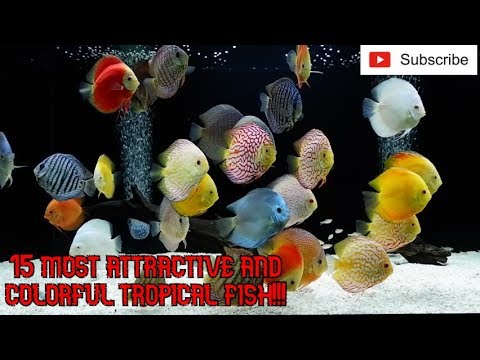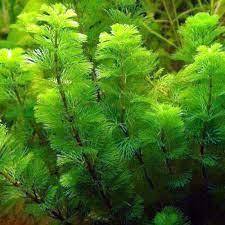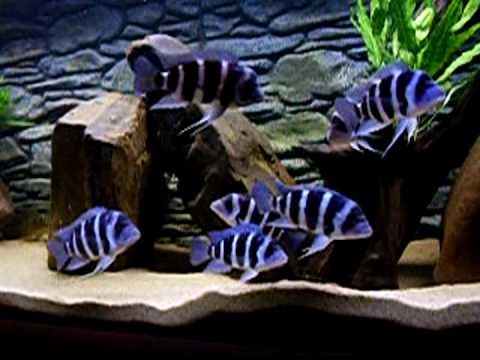Colorful Tropical Fish
5 years ago admin 0
Most colorful tropical fish
Colorful Tropical Fish. There’s an incredible variety of fish within the aquatic world to choose from. Many colorful freshwater fish are compatible with one another as tank mates. So this allows the hobbyists to create a rainbow of colors within their aquariums. In this video I will be looking into the 15 most attractive and colorful freshwater fish you can have in your aquarium. Also I have included the aquarium types and the size of tank you require to have those fish. So let’s begin. First on my freshwater fish list we have Discus.
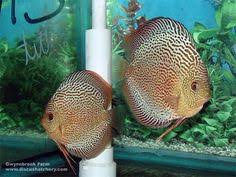
Discus
The Discus are considered the holy grail for a ton of fresh water fish keepers. These amazingly colorful tropical fish come in an array of patterns and are identifiable by their unique red irises. That being said the discus is a high maintenance fish. This due to its requirement for extremely clean water with a specific pH level of 5 to 7. Discus prefer aquariums with dense foliage and natural hiding spots to mimic the environment of their wild counterparts. They eat live foods including brine shrimp and worms. With a brilliant stripe pattern and striking colors of the discus make it a popular choice for freshwater aquariums.
Ease of care for these fish is intermediate to advanced due to the complex habitat and feeding requirements. Discus fish is a social fish that do well in schools and with other fish including many other fish that we will discuss in this video. The required tank size for discus fish is 40 gallons for an individual and 50 gallons or more for a small school of fish which can be up to six fish. Next on the list we have the German Blue Rams fish.
German Blue Rams
This unique freshwater fish stands out for the fluorescent blue dots that cover an otherwise yellow and orange body as well as its unique spiked dorsal fIn. Rams are also highly compatible with many other species of fish due to their social and peaceful nature. Rams can be kept as individuals in small schools or just as a pair as these fish tend to choose only one mate. They are also a much lower maintenance fish due to their temperament. They simply require a freshwater tank preferably with soft water with caves or other hiding spots, especially in the case of a breeding pair. Also they will need a location to lay eggs.
As these fish can be maintained for low cost and is easy to take care of beginners can choose this fish to start with. 30 gallons or more tank size are required for having these fish in. The third on this list we have the Gourami.
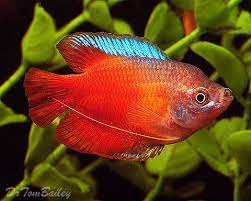
Gourami
There are many varieties of Gourami that may catch the eye of the aquarist seeking highly colorful tropical fish. The flame Dwarf Gourami features deep blue coloration that transitions into a bright flame red towards the tail. The Neon Blue Dwarf Gourami is just that striking neon blue with spots of red and orange along its scales. There are many other variants of the Gourami which differ by size though females tend to be paler in color across all variants. The Gourami is a peaceful fish that requires dense foliage to swim through. They can be kept as individuals or a mating pair. Mates will use the foliage in the tank to help create the bubble nests as cover for their eggs.
Water changes have to be done frequently to keep the water fresh in order to avoid diseases. Compatibility for Gouramis is good. Males may become territorial depending upon the combination of fish with the right mixture of size and species and the right environmental conditions. The required tank size for Gouramis is 10 gallons or more. And the next on the list is the Diamond Neon Tetra.

Diamond Neon Tetra
These small fish are happiest when kept in schools of five to six or more and have plenty of features within the tank to use as hiding spots. The Diamond Neon Tetra specifically has a blue stripe that runs down the side of its body interrupting the overall reddish hue in addition to a metallic diamond strip in the region of the dorsal fin which develops as the fish matures. Tetras can be a bit skittish but when provided with a small school and sufficient hiding spots they will feel secure enough to make their presence known and explore the tank.
Beginners can start with this fish as it is easy to take care of. As long as you keep these fish in a school they should be peaceful in the community tank. Preferred tank requirement for this fish is 15 gallons or more.

The Endler
Next is the Endler livebearer fish. There are many varieties of the Endler livebearer fish all with exotic colorations. the red flame Endler is among the most popular due to its electric red and green teal tones. Endlers require harder water than some other freshwater species which must be considered when selecting tank mates. These fish stay quite small, the male’s only reaching an adult size of approximately one inch. Though they are not schooling fish they are friendly and can be housed in the same tank amicably. Also beginners can find it suitable to start with this fish as it doesn’t require much attention. Required tank size for this fishes is twenty gallons or more
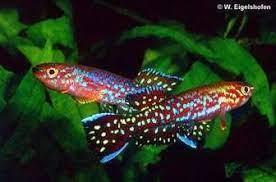
The Killifish
The Killifish is an active schooling fish who is known for its variety of neon colors and its tendency to jump. Killifish are best kept in small schools with only one male and several females as the males can become aggressive towards each other. Some Killifish species are endangered and cannot be kept by hobbyists but there are more common varieties available for sale. Killifish along with most of the other fish on this list require an abundance of hiding spots and adequate foliage to feel secure.
Compatibility varies based on species. Some can be housed in communities with Tetras, Danios etc but other species should be kept in species only tanks due to their special requirements. Twenty gallons per mating pair required for this fish.

Boeseman’s Rainbow fish
This species is unique in its coloration which starts as a metallic silver and grey at the head and becomes an increasingly bright yellow with orange towards the tail. This color is encouraged by a specified diet and the proper maintenance of the tank waters hardness and pH. Rainbow fish grow to an adult size of three to four inches and are happiest when kept in groups of six to eight. The Boeseman’s rainbow fish also requires dense foliage within the tank in addition to an area for open swimming in order to recreate the conditions of their natural habitat.
Due to tank requirements ease of care can be intermediate for this fish. Compatibility is good but should be housed with other fish of a similar size to avoid startling smaller fish. Possible tank mates include cichlids , catfish or other rainbows. Thirty gallons or more is the required tank size for these fish.
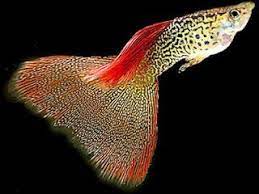
The Fantail Guppy
Fantail Guppies are a classic choice for hobbyists just looking to add some color to their tanks. they get their name from their dorsal fin which is large in comparison to its body and fans out broadly. Fantail Guppies can vary in color from neon yellow to lime green to teal and which are often interspersed with black or silver making the colors even more striking. Guppies stay relatively small at approximately 2.5 inches and are most at home in small schools. They are friendly fish which do well when housed with other schooling fish such as Tetras Gouramis or Platies but you need to make sure that you do not put them in tanks with fish that might prey on them. The golden rule for tank size requirement for this fish is two gallons of water per guppy.
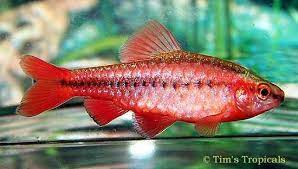
Cherry Barb
Next we have the Cherry Barb. These fish are unique for their coloration which changes in the males during spawning. The overall color of the fish is silver or white but during spawning males turn bright cherry red. Hence their name. Cherry Barb’s are an easygoing fish to maintain. They require room to swim openly as well as vegetation in which to hide. They may be skittish individually but are comfortable in small schools. It’s an easy fish to take care of so beginners are welcome to start with. This fish’S compatibility is good especially when housed with other small schooling fish such as Tetras Mollies or Danios. Aquariums of ten gallons or more in size required for these fish.
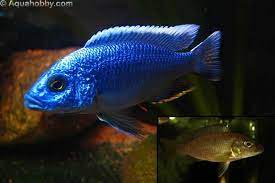
Electric-blue Hap
Following on this list we have the Electric-blue Hap. The male of the species is the one who makes the list with his stunning julienne blue scales. The female counterpart to the electric blue Hap is actually a gray and silver tone. The Hapis one of many species of cichlid with a slightly forked tail. Blue Haps are schooling fish who are best kept in groups of three to six females in one male or in breeding pairs. These cichlids grow to about 6 inches in length when fully mature and their tank environment should mirror that of their natural habitat with large rocks and hearty plants but no driftwood. These stunning fish stand out in any aquarium.
This is an easy fish to take care of. Only one male of the electric-blue Hap should be permitted per tank. Required tank sizes fifty five gallons or more

Reuben Red Peacock cichlid
Next is the Reuben Red Peacock cichlid. The Reuben Red Peacock is appropriately named.. Its scales form a patchwork of bright red – Deep blue to violet scales peppered with silver. This popular cichlid variant is much like the electric blue Hap with the sexual diamorphism of its scale colors, with the females having muddled gray or brown scales. The Peacock cichlid follows the same habitats and pairing requirements as its electric blue counterpart. it’s an easy fish to have in your aquarium. again only one male should be allowed to protect against and to reduce aggression. Required tank size required is fifty five gallons or more
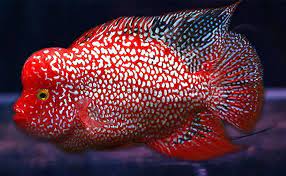
The Flowerhorn cichlid
This is a peculiar fish that stands out from the other cichlid varieties in a big way. The Flowerhorn cichlid is so named for the large mass on its forehead present in both males and females. Its bulky body features a variegated pattern with extreme color variation based on breeding and hybridization. Additionally the colors of an individual Flowerhorn can change until maturity is reached. The Flowerhorn cichlid does require plenty of space and is known for being territorial. But is easy to care for in the aquarium.
Compatibility is low for these fish. Flowerhorns can be aggressive and interact poorly with tank mates. It is recommended to provide an individual tank for Flowerhorns in order to avoid causing stress in smaller fish. when kept individually they are pleasant fish with immense payoff for their size and beauty. Required tank size is fifty five gallons or more.
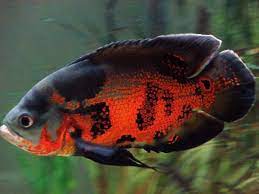
Oscar cichlids
Oscars are another variety of cichlid with their own array of color shape and size variations. In addition to their remarkable pigmentation Oscars are also renowned for their intelligence among other fish species. Some Oscars have been said to play and interact with their owners including showing signs of excitement when their owner enters the room. One drawback of the Oscar fish is the cichlid aggression that tends to arise from these fish. Despite this it is possible to house Oscars with tank mates as long as they are introduced and housed responsibly and with discretion.
In order to avoid the Oscars showing aggression advanced caretaking is required for this fish as it requires unique habitats and personality. Oscars should be given enough room to reduce the chance of aggressive behaviors and tank mates should be introduced with great discretion. Fifty five gallons PER FISH is required in the tank for these fish.

Next is the Duboisi cichlid. The Duboisi cichlid is one of many varieties of cichlids popular for their high level of activity and individual personalities. These cichlids undergo transformation and color and pattern as they age making them a distinctive choice for color seekers. Duboisi cichlids are black with blue and white spots and as the fish age they lose their spots and gain a bluish tint and yellowish white band around their middle/. they are best kept in species-specific schools of approximately eight to ten fish due to their strong social structure and aggressive nature. Special care and attention are required to have this fish. These fish should be kept in species-specific tanks due to aggressive tendencies. Required tank size is fifty five gallons or more PER FISH.

The Zebra Danio
The name of this fish speaks for itself. the Zebra Danio is characterized by horizontal stripes that run the length of their body and maybe silver gold or white in color contrasted by black deep indigo or even dark green stripes. These fish provide excellent visual divergence from some of the other fish listed here and are perfect to include with other colorful freshwater fish due to their peaceful nature. Danios stay small even into adulthood, maintaining a length of about two inches.
Danios are highly social and should only ever be kept in small schools. Caring for this fish is easy. The compatibility with other fish is excellent for this fish especially when kept as a school within a community tank. Ten gallons or more is required for this fish.
Advertisement>Live tropical fish for sale on amazon.com
As you can see there are tons of colorful tropical fish available for purchase at most local fish stores. In addition most of the fish on our list don’t require specialized to care and do great in community aquariums. Make sure to keep up with basic water changes and feedings and your freshwater aquarium should be healthy lively and colorful for years to come.

